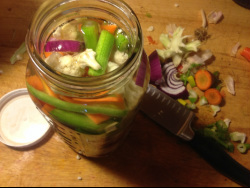
Fermenting vegetables, like sauerkraut and traditional brined pickles, is one of the oldest preservation methods. When you put vegetables in a salt brine, only a few of the many naturally-occurring organisms can survive - and they happen to be ones that improve the flavor and nutritional value of the vegetables, while extending their storage ability. They're mostly lactobateria, the same class of microbes that turn milk into yogurt. (Lactobacteria also help preserve salami, while other fermentation processes are responsible for sourdough bread, soy sauce, cheese, chocolate, coffee, alcoholic beverages, and more.)
The real key, for us, is that fermented vegetables are quick and easy. All you need is a non-reactive container (mason jars work great), salt, water, and whatever you plan to pickle. No boiling, no vinegar fumes, no chance of botulism. You want to get the salt ratio right - that's what prevents unfriendly bacteria from moving in - but beyond that, it's pretty impossible to mess up. (And if you do mess up, there's very little doubt, and little that could compel you to eat the stinky, slimy mess you've made.)
We currently have sauerkraut, cucumbers, kohlrabi, cauliflower, beets, and a big jar of mixed vegetables in some stage of fermentation. (The picture above is the mix - cauliflower, carrots, onions, fennel stalks, garlic, and green beans with thyme.) We make a new jar every day or two, because we finish a jar every day or two. It's a great way to use up some veggies and add a healthful and tasty zing to your meals and snacks.
(Find our Basic Brined Pickle recipe here!)


 RSS Feed
RSS Feed
